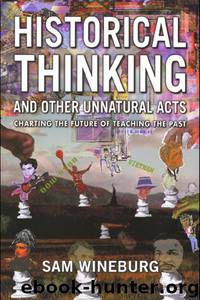Historical Thinking and Other Unnatural Acts: Charting the Future of Teaching the Past by Wineburg Sam

Author:Wineburg, Sam
Language: eng
Format: epub
Publisher: Temple University Press
Thirteen of fifteen multiple-figure drawings by girls (87 percent) depicted men and women together, and twelve of the fifteen (80 percent) depicted images of couples or families (see Figure 5.2). For these twelve girls, a “Pilgrim” “Settler” or “Hippie” was represented not by a single figure, but by a family or social unit.
The “family image” was not the picture elicited from boys. Boys who drew multiple figures in part 1 were no more likely to envision a past inhabited by women than were the boys who drew single figures. All five of the boys who drew multiple figures drew men (Table 5.3), and in three of five cases the images contained violent overtones (see Figure 5.3). In other words, when boys drew multiple figures, their pictures more often showed men engaged in combat than in cooperation.20
Would a task that instructed students to draw multiple figures lead to a greater number of mixed-sex pictures of Pilgrims, Settlers, and Hippies? This question was addressed by examining the responses in part 2 of the questionnaire. We wondered how the student's responses in this section, in which they were asked to illustrate a gender-neutral passage about Pilgrims, Settlers, or Hippies, would compare with their responses in part 1, the depiction of a single figure.
Again, a majority of boys (57 percent, or thirty-four of the sixty boys who completed part 2) responded by drawing male figures (Table 5.4). Although this number is less than the 91 percent who drew male figures in part 1 (recall that boys'#x0027;s drawings of multiple figures showed only men), none of the boys'#x0027;s drawings in part 2 depicted women alone. In addition, the category showing the greatest increase was not “both male and female” but “ambiguous.” Although the number of boys who included women in their drawings rose from one in part 1 (the single female Hippie) to seven in part 2, the number of ambiguous figures increased fourfold. Reasons for this rise, we speculated, might include one or both of the following: the constraints of the task left students with little time or motivation to complete a detailed drawing (there were many stick-figure drawings in part 2); or the scene students were asked to illustrate (Pilgrims farming, Settlers in a wagon, or Hippies at a protest) was not suited to close-up detail.
The data from girls, however, provided little support for either explanation. While sixteen fewer boys completed part 2 than part 1, only seven fewer girls failed to complete their illustrations of textbook passages, suggesting that the time allotted to complete the questionnaire was adequate. In addition, as Table 5.5 shows, the percentage of girls' responses coded as “ambiguous” did not increase significantly from part 1 to part 2; even in these “far-away” scenes, girls included sufficient detail to distinguish male from female figures. (Are girls simply more conscientious students and more detail-oriented? If this is the case, then why did 19 percent of the girls disregard the directions in part 1?)21
Download
This site does not store any files on its server. We only index and link to content provided by other sites. Please contact the content providers to delete copyright contents if any and email us, we'll remove relevant links or contents immediately.
| Arts & Humanities | Health |
| Language Arts | Library Skills |
| Mathematics | Reading & Phonics |
| Science & Technology | Social Studies |
The Art of Coaching Workbook by Elena Aguilar(50984)
Trainspotting by Irvine Welsh(21518)
Twilight of the Idols With the Antichrist and Ecce Homo by Friedrich Nietzsche(18503)
Fangirl by Rainbow Rowell(9095)
Periodization Training for Sports by Tudor Bompa(8170)
Change Your Questions, Change Your Life by Marilee Adams(7635)
This Is How You Lose Her by Junot Diaz(6794)
Asking the Right Questions: A Guide to Critical Thinking by M. Neil Browne & Stuart M. Keeley(5632)
Grit by Angela Duckworth(5521)
Red Sparrow by Jason Matthews(5390)
Paper Towns by Green John(5089)
Room 212 by Kate Stewart(5035)
Ken Follett - World without end by Ken Follett(4645)
Housekeeping by Marilynne Robinson(4344)
The Sports Rules Book by Human Kinetics(4290)
Double Down (Diary of a Wimpy Kid Book 11) by Jeff Kinney(4207)
Papillon (English) by Henri Charrière(4195)
The Motorcycle Diaries by Ernesto Che Guevara(4012)
Exercise Technique Manual for Resistance Training by National Strength & Conditioning Association(3955)
